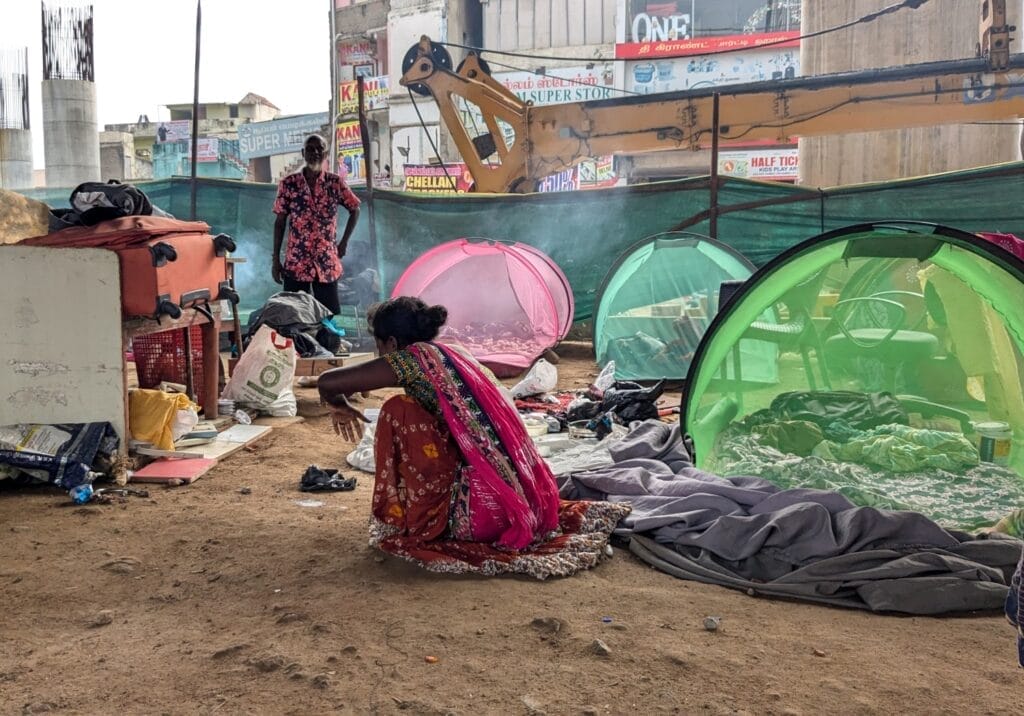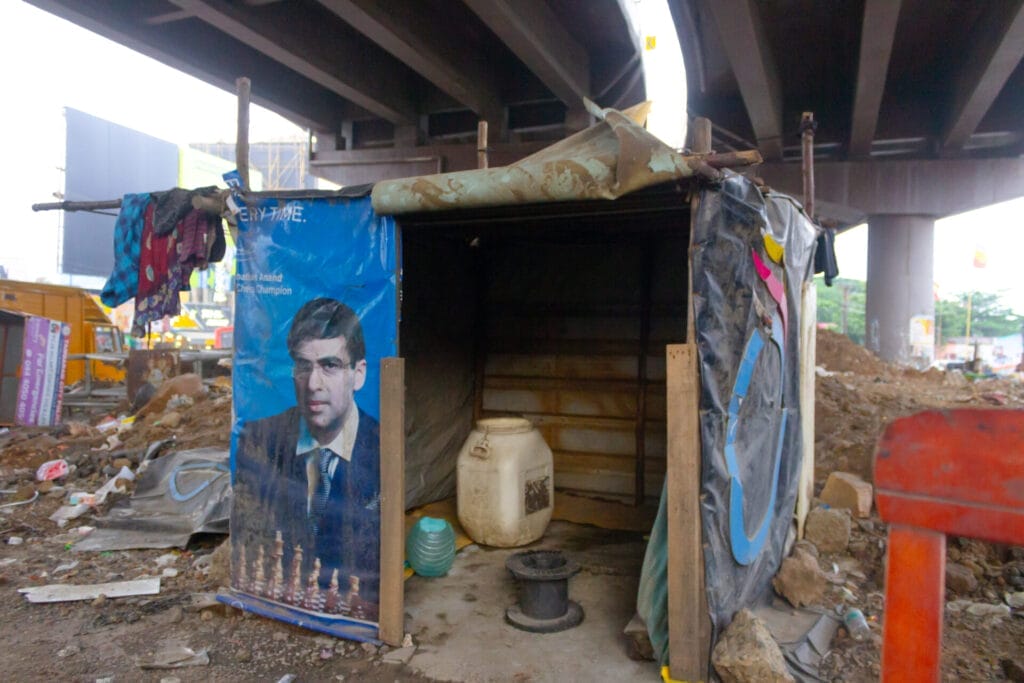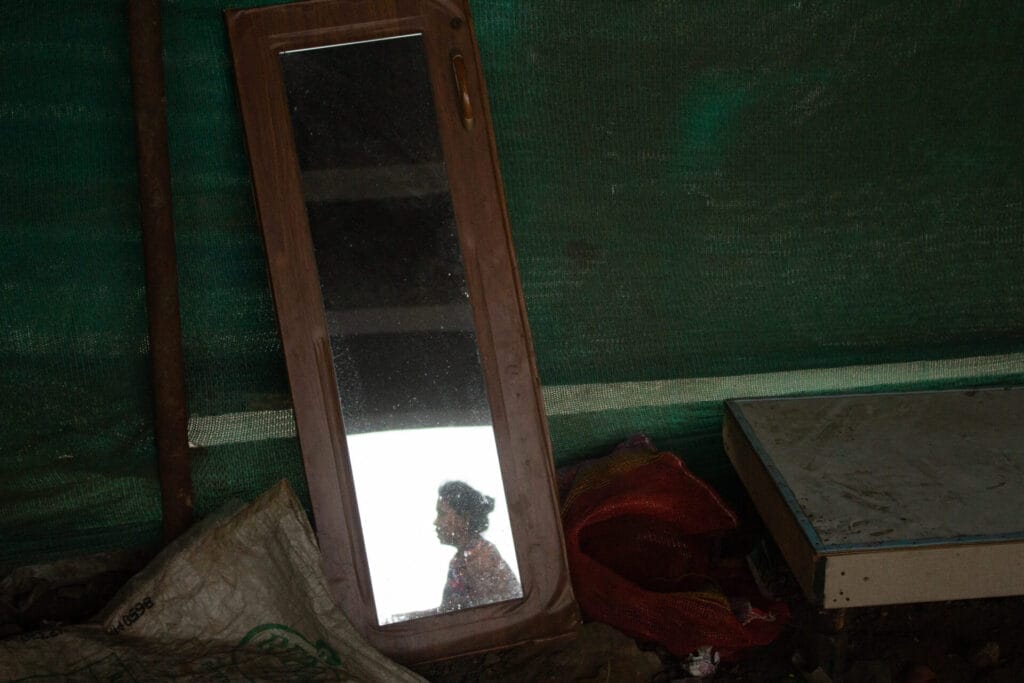Makeshift homes made with mosquito nets, broken chairs, and tables and groups of families making and selling beaded ornaments under Chennai’s longest flyover. This may be a familiar sight for commuters travelling along Velachery, Madipakkam and Sholinganallur. Ever wondered who are these people and why they live on the streets?
The Narikurava tribal community living under the Medavakkam flyover in Chennai faces daily struggles that often go unnoticed. The 2.3-km unidirectional flyover, inaugurated in May 2022, facilitates faster travel from Tambaram to Velachery and is a boon for commuters. But families living under the overpass have many concerns. They face displacement, as the area under the flyover will be beautified as part of the Singara Chennai initiative. The State Highways Department plans to start this project after the ongoing Metro Rail works at Medavakkam are concluded.
No place to call home

Read more: School, interrupted: The toll of mid-academic year evictions on children in Chennai
While the project is part of the city’s urban development plan, it raises pertinent questions: what will happen to the people living here? Will they lose their homes and livelihoods? Will the authorities provide them with housing? Despite initiatives to uplift the urban poor, families like these remain unnoticed and underrepresented.
For the past 20 years or so, these individuals have been living in and around Medavakkam, earning their livelihood by picking and selling papers, working at hotels, and selling bead ornaments. Pawar Thulkana and Indrani, a couple, have been residing under the bridge for the past three years. “I was born in this city, and I have lived in places like Kotturpuram and Thiruvanmiyur since birth. Whenever officials ask us to relocate, we move to different places, and 20 years ago, we came to Medavakkam. Now, we face the threat of eviction again, when they ask us to leave. Until then, we consider this space our home,” says Pawar.
Difficulty in accessing basic facilities

Narikuravans (Kurivikkarans) of Tamil Nadu were added to the Scheduled Tribes list by amending the Constitution (Scheduled Tribes) as notified by a Government of India order dated March 3, 2023.
However, nomadic communities in Tamil Nadu encounter significant obstacles in accessing basic services, despite possessing Voter ID and Aadhaar. According to Rajasekaran, a Narikurava leader and member of the Tamil Nadu Tribal Advisory Council, the absence of a universal system specifically tailored to their needs leaves these communities underserved.

The Narikuravas, or Kurivikarars, have historically relied on hunting as both a livelihood and cultural tradition. However, after the Wildlife Protection Act banned hunting, it uprooted their way of life. Many turned to making bead ornaments and crafting women’s essentials to survive. While these efforts showcase their resilience, the income is often meagre, leaving families in economic hardship.
Need for support
This transition has disrupted their livelihoods and challenged their cultural identity. The Narikuravas’ story is one of strength and survival, but it highlights the urgent need for support to help them preserve their heritage while securing sustainable livelihoods.
In a related concern, Rajasekaran highlights the reduction in loans provided by the Tamil Nadu Adi Dravidar Housing and Development Corporation (TAHDCO) to Scheduled Tribes. Previously, these loans were offered at 50%, but this has now been reduced to 35% following the inclusion of Narikuravas. The question remains: what benefits have these communities gained since their inclusion, and does the reduction in loan percentage undermine their access to financial support?
“While some have Aadhaar and other ID proof, many community members lack the necessary identity documents, preventing them from completing the process required to access basic services. This lack of documentation remains a key obstacle,” says Rajasekaran.

In response to these issues, TAHDCO plans to offer loans through community-based groups. These loans, which will be funded by the National Scheduled Tribes Finance and Development Corporation (NSTFDC), aim to meet the financial needs of these marginalised communities, although challenges remain in ensuring they can fully benefit from these schemes, according to Rajasekaran.
Rental housing: A viable option
Vanessa Peter, founder of the Information and Resource Centre for the Deprived Urban Communities (IRCDUC), emphasises the importance of providing jobs to the urban homeless.
“Many of these individuals come from different parts of the state or other states to work. If the government cannot provide them with homes, rental housing boards are a viable option, where people can live and pay a minimal amount. This applies not only to the Narikuravas living under the Medavakkam bridge but also to those residing in Ambattur and other parts of the city. Accommodation in rental housing boards would enable these individuals to be self-sufficient,” says Vanessa.
Moreover, these sites should cater to families. Currently, Chennai has 47 shelter homes divided by gender, which deters people from utilising them, she adds.
Without the implementation of such schemes, these individuals will remain marginalised, even though they have ST status. In a recent meeting with the advisory council, the tribal welfare department was advised to appoint a member representative from the same community to address their demands and help improve their socio-economic conditions.
“To enhance their livelihood opportunities, the government can establish small-scale bead-making units, leveraging the community’s unique ability to be both producers and marketers. Notably, the Narikurava community can meet demand and supply single-handedly. However, the gap is in the lack of resources available to them,” adds Rajasekaran.
How the beautification project affects Narikuravas
As Thulkana fears, it could be anytime soon when officials ask them to leave, and they have no choice but to comply. When Citizen Matters attempted to contact the State Highways Department for information on the rehabilitation and eviction process, we were informed that the project proposal had not been released yet. The bridge beautification project will only begin after the completion of the ongoing CMRL project. Additionally, the project will fall under the Construction and Maintenance Wing, with the budget allocation to be determined later, officials said.
Although no proper budget has been reportedly released, the question remains whether the government has any budget for the eviction and rehabilitation of these individuals. Should they have to wait again, as they have already spent enough time without a place to call “home”? Where has the system been all these years while Thulkana and Indrani raised five children on the streets of Chennai? These questions beg immediate answers.